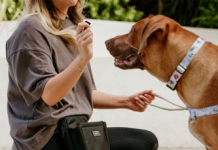Dog hip dysplasia comes from an inherited condition. It is chiefly the result of a malformed hip joint. When the joint is loose, a dog’s leg bone will move around too much and this creates excess wear and tear. But how do you know if your dog has hip dysplasia? Here’s some information to help you spot the signs and symptoms and get your dog to a vet as soon as possible.
Symptoms
In mild cases, the symptoms of hip dysplasia aren’t visible, but in moderate to severe cases, you will see your dog limping, not wanting to exercise and perhaps even having trouble standing after urinating or defecating. One sure sign of potential hip dysplasia is if, when your dog runs, he bunny hops rather than using both legs independently to propel him forward.
Is Your Dog Prone?
Hip dysplasia shows itself most prominently in large or giant breed dogs like Saint Bernards, retrievers and Rottweilers but any breed can be susceptible. This condition can show itself as early as five months old and then worsen as the dog grows older. However, you could also have a puppy that’s perfectly fine until they get to be geriatric and the symptoms present themselves in an acute fashion.
Is There a Cure?
Sadly, there is no cure for dysplasia because it’s an inherited defect in the hip. You can’t prevent the development of this disease, however, your dog can have complete hip replacement.
There is treatment for the pain and stiffness with medication that your veterinarian can prescribe. Your vet can also help you with a pain-relieving program that’s right for your dog including options for exercise. If your doctor prescribes exercise, and walking is difficult for your pet, consider finding a canine aquatic program in your area because swimming is great exercise that won’t stress her joints.
Pain Management
Besides providing pain medication, talk to your vet about massaging around the hip joints as well as using moist heat. Get your dog a firm orthopedic bed to sleep on and, if you have slippery floors, lay some runners down so yout doesn’t feel insecure about walking on the floor.
Hip dysplasia isn’t preventable but, with some forethought, you can make your dog as comfortable as possible.
Photo Credit: istockphoto.com











